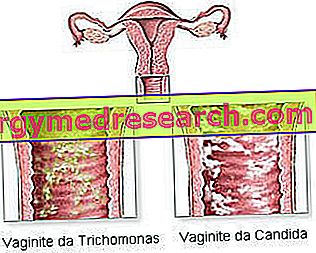Definition of vaginitis
"Vaginitis" is a general expression that refers to an acute inflammatory process affecting the vagina, responsible for local pain, itching and inflammation, often associated with whitish, sometimes foul-smelling vaginal discharge . Frequently, vaginitis is the most immediate consequence to an alteration of vaginal bacterial balance, although it can also be caused by bacterial infections and significant hormonal alterations;

Classification and causes
As analyzed, vaginitis is a rather general term, which indicates an inflammation of the vagina; due to the generality of the word, it is good to distinguish several variants:
- Atrophic vaginitis or climacteric vaginitis : a consequence of the marked reduction in the hormonal estrogenic structure after menopause. In this case, inflammation of the vagina is caused by chronic vaginal dryness and thinning of the mucosa. Atrophic vaginitis, however, can also occur after childbirth, during breastfeeding or after surgical removal of the ovaries.
- Bacterial vaginitis : inflammation of the vaginal mucosa is a consequence of a bacterial insult. The microorganisms most involved in the onset of vaginitis are Prevotella, Mobiluncus, Gardnerella vaginalis and Mycoplasma hominis, which replace the lactobacilli of doderlein: it follows a marked imbalance between the "good" bacteria (that live in symbiosis with the host) and those "bad" (which, instead, damage it). This variant of vaginitis is therefore caused by an alteration of the bacterial population that normally lives in the vagina, although the reason that arises at the origins of this microbiological change is not known. Bacterial vaginitis is a sexually transmitted disease.
- Fungal vaginitis: Candida albicans is the main fungus responsible for fungal vaginitis. It is estimated that 75% of women have contracted Candida infection at least once in their life. The risk of contracting Candida vaginitis seems to increase enormously depending on several factors: stress, poor nutrition, excessive vaginal lavage, taking birth control pills, administration of antibiotics and steroid drugs, menopause. Women with HIV and diabetes are even more susceptible to infections.
- Parasitic vaginitis : even parasites can promote inflammation of the vagina; the pathogenic microorganism involved here is Trichomonas vaginalis, often transmitted by sexual means. In the context of parasitic vaginosis, Trichomonas triggers inflammation in the cervix, also involving the urethra.
- Non-infectious vaginitis : inflammation of the vagina is not necessarily caused by pathogens; some women complain of vaginal inflammation following frequent washing with aggressive or irritating detergents, or after the application of spermicidal substances. Apparently, even the most adherent clothing can increase the risk of vaginitis.
Vaginitis: symptoms
To learn more: Symptoms Vaginitis
In general, the symptoms that are often associated with vaginitis include: alteration of color, odor and whitish vaginal discharge, pain during intercourse (dyspareunia), pain during urination, vaginal irritation, mild vaginal bleeding, itching vaginal, spotting. Atrophic vaginitis, in addition to manifesting itself with many of the symptoms listed above, often causes an unpleasant perception of vaginal dryness.
Clearly, the symptoms differ slightly depending on the causative agent: for example, in the case of bacterial vaginitis, vaginal discharge takes on a greyish color, never transparent, and is always smelly (so much so that the smell is even compared to that of rotten fish). Candida infections, on the other hand, cause whitish, non-smelly vaginal discharge, comparable to ricotta. Trichomonas vaginitis is often the easiest to diagnose, since vaginal discharge takes on a dramatically different color, greenish and frothy.
Diagnosis
It is advisable to seek medical attention as soon as possible after the onset of symptoms, to prevent the inflammation from worsening and, possibly, to pass the disease to the partner. After the description of the symptoms, the doctor proceeds with a careful gynecological investigation, focusing attention on the external genitalia, vagina and cervix. The investigation proceeds with the pH analysis: generally, the physiological vaginal pH is around the value of 4.6; in the presence of bacterial vaginitis, the pH tends to increase.
The collection of a sample of vaginal secretion is useful to confirm or not a sexually transmitted infection: for this reason, the doctor can also perform the test for chlamydia, gonorrhea, HIV and syphilis.
Vaginitis - Video: Causes Symptoms Diagnosis Cures
X Problems with video playback? Reload from YouTube Go to Video Page Go to Wellness Destination Watch the video on youtubeTreatments and drugs
See also: Medicines for the treatment of vaginitis - Remedies for vaginitis
Like all pathologies, the treatment for the treatment of vaginitis is subordinated to the cause that arises there. To treat bacterial vaginitis, antibiotics are certainly the first-line drugs, to be taken systemically, such as metronidazole and tinidazole, and to be applied directly in situ to exercise immediate pharmacological activity (eg clindamycin cream). The treatment should generally last for 5-7 days; it is advisable to apply the ointment twice a day.
In the event of a Candida infection, vaginitis should be treated with specific antifungal drugs, such as itraconazole, clotrimazole, cancidas and anidulafungin.
Clearly, when vaginitis is not caused by an infection, antibiotics or antifungals are not the most indicated drugs; in all probability, the atrophic vaginitis depends on an alteration of the hormonal attitude, often due to a physiological reduction of the estrogens during the post-menopausal period. To restore hormone levels, decreasing the symptoms of vaginal inflammation, it is recommended to take estradiol, possibly associated with norethindrone, esterified estrogens or Estropipato. For the dosage: read the article on drugs for the treatment of vaginitis. Also read the article on drugs for treating menopausal symptoms.
To alleviate the vaginal dryness that often accompanies all the various types of vaginitis, it is recommended to apply lubricating creams several times a day, which exercise their therapeutic activity by mimicking vaginal secretions; to emphasize, however, that these creams do not intervene in any way on the cause that triggered vaginitis.



